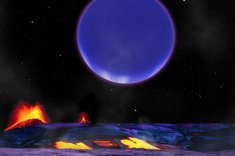Artist’s illustration of the potentially life-supporting “super-Earth” planet K2-18b and its newfound neighbor, K2-18c. Both planets orbit the red-dwarf star K2-18, which lies 111 light-years from Earth, in the constellation Leo.
A possibly habitable alien world may be rocky like Earth — and it has a neighbor, a new study reports.
The potentially rocky exoplanet is K2-18b, which lies 111 light-years from Earth in the constellation Leo. It was discovered in 2015 by researchers using NASA’s prolific Kepler space telescope .
Those original observations revealed that K2-18b likely orbits in the habitable zone of its dim red-dwarf star — that is, within the range of distances where liquid water could exist on a world’s surface. In addition, the discovery team found that K2-18b is about 2.2 times bigger than our planet, making it a so-called “super-Earth.” [How Habitable Zones for Alien Planets and Stars Work (Infographic) ]
Super-Earths straddle the fuzzy size boundary between terrestrial planets and gaseous worlds like Neptune, so the makeup of K2-18b was unclear. A team of astronomers therefore studied the planet with the High Accuracy Radial velocity Planet Searcher (HARPS), an instrument installed on the 11.8-foot (3.6 meters) telescope at the European Southern Observatory’s La Silla Observatory in Chile.
HARPS detects the tiny wobbles that orbiting planets’ gravitational tugs induce in their host stars’ movements. Such “radial velocity ” data can help pin down the alien worlds’ mass, allowing astronomers to calculate their densities (provided their diameters are known) and make inferences about their composition.
In this case, the HARPS observations suggest one of two options for K2-18b: It’s either a rocky world with a thin atmosphere, like Earth, or a water world covered with a shell of ice, study team members said.
“With the current data, we can’t distinguish between those two possibilities,” study lead author Ryan Cloutier, a Ph.D. student at the University of Toronto and the University of Montreal’s Institute for Research on Exoplanets, said in a statement. “But with the James Webb Space Telescope , we can probe the atmosphere and see whether it has an extensive atmosphere or it’s a planet covered in water.”
NASA’s $8.9 billion JWST, the highly anticipated successor to the agency’s Hubble Space Telescope, is scheduled to launch in early 2019. Astronomers will use the new telescope to make a range of observations, from studying the universe’s earliest stars and galaxies to scanning the atmospheres of nearby exoplanets for potential signs of life.

0 of 10 questions complete
“K2-18b is now one of the best targets for atmospheric study; it’s going to the near top of the list,” study co-author René Doyon said in the same statement . Doyon is principal investigator for the Near-InfraRed Imager and Slitless Spectrograph, a Canadian Space Agency instrument on board JWST.
K2-18b circles its parent star every 33 days. But the study team also noticed another signal in the HARPS data that kept recurring every nine days. After performing a series of analyses to make sure the mystery signal wasn’t just noise, the researchers determined they’d found a new planet.
“Being able to measure the mass and density of K2-18b was tremendous, but to discover a new exoplanet was lucky and equally exciting,” Cloutier said.
The newfound K2-18c seems to be a super-Earth, like its sibling. But the similarities may end there; the closer-orbiting K2-18c is probably too hot to support life as we know it, study team members said.
Follow Mike Wall on Twitter @michaeldwall and Google+ . Follow us @Spacedotcom , Facebook or Google+ . Originally published on Space.com .

Comments are closed.